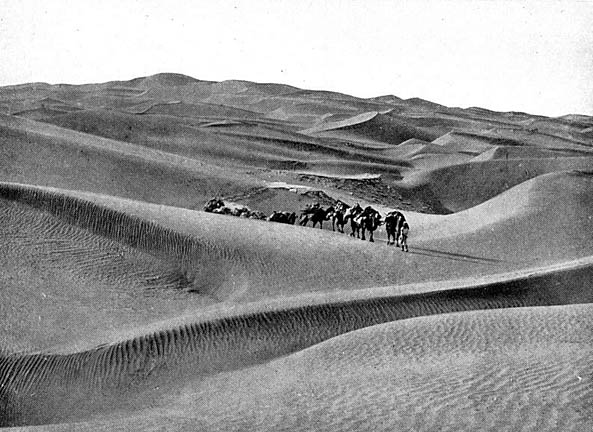
Marching through the high dunes southwest of Maralbashi
Sir Aurel Stein's Third Expedition
1913-1916
On
Google Earth
To open this map you have to download
GE onto your hard-disc
Collection of Stein's expedition maps as Google-Earth overlays (inaccurate but still very useful!)
Stein's
Third Expedition
Stein’s
third expedition to Central Asia was his longest. The
route chosen for approaching the desert was a new one, taking him
through the mountain territories of Darel and Tangir,
mentioned in the accounts of Chinese pilgrims, but never before
visited by Europeans. From Kashgar he travelled east along the foot
of the Tianshan mountain range, then across the Taklamakan desert to
the south. On route, useful antiquarian observations were made before
arriving at the oasis of Khotan in November 1913.
From there the journey to Lop Nor followed the old caravan route, allowing him to trace more remains in Domoko, Niya River, and Miran. He set out on 1 February 1914 into the waterless desert northward, moving towards Loulan, a new route.
Following the ancient border line discovered during the second expedition he arrived again at Dunhuang by the close of March 1914.
He successfully traced the border eastwards for another 250 miles to the Etsin Gol River. In May he reached Karakhoto, which he identified with the city of “Etzina”, described by Marco Polo, who had taken the same routes in the 13th century.
In June 1914, Stein had to stop his work at desert sites because of the increasing heat, turning his attention to the Nanshan range. From September 1914, he set out on a journey of some 500 miles along unsurveyed routes, right across the desert ranges of the Beishan mountain to the easternmost Tianshan range.The journey along its northern foot acquainted him with a part of Dzungaria. He excavated sites near Turfan on the northern Silk Road, especially in Astana and Bezeklik
In June 1915, Stein returned to Kashgar. Then he started a three month journey, during which approximately 1,700 miles were covered on foot and horseback across the Pamirs into Russian Turkestan. He arrived at Samarkand in October 1915. From there he reached the Persian border by rail, and travelled along the Persian-Afghan border. He reached the area around Sistan (Chistan, Sakastan) in early December 1915.
There he began a third winter’s archaeological campaign in ancient Sakastan. Among the extensive ruins of a palace on the isolated rocky hill of Koh-i-Kwaja, he discovered the remains of wall paintings, the oldest ones brought to light in Iran. Some of them, distinctly Hellenistic in style, probably dated from Parthian times, illustrating an Iranian link between the Greco-Buddhist art of north-western India and the Buddhist art of Central Asia. Another interesting discovery in the same area was that of a chain of watch towers that form an exact counterpart to the Chinese Han limes (border defenses), and date from the Parthian period.
Stein returned to India in March 1916.
From stein.mtak.hu
Because Europe was embroiled in WW I - which is only incidentally metioned - the third expedition (1913-16) was funded entirely by the Government of India. The intention was that the majority of finds from this expedition should be the foundation of a new museum in New Delhi, and that representative specimen and 'literary remains' should be presented to the British Museum (which had to wait until 1922).
To reduce the size of this webpage, I have omitted routes and places Stein described extensively on his Second Expedition in favor of emphasizing new finds at the Loulan Grave Sites, Karakhoto, the Astana Cemetery, and his traverse of the Russian Pamirs. You find them on the Google-Earth Map.
Details of this expedition are buried in the 1000 pages of “Innermost Asia”
For faster reading I recommend the comprehensive, one-volume description of Stein's travels in "On Ancient Central Asian Tracks"
Srinagar-Darel and Tangir
Valleys-Wakhan-Tashkurgan-to Kashgar
May – Sep
1913
To vary his route Stein approached Turkestan through the uncharted Darel and Tangir Valleys, crossed the familiar Baroghil Pass into the Wakhan and via Tashkurgan to Kashgar, a journey of nearly 6 months.
Kashgar
Sep 21 -
Oct 9, 1913
Kichik Beg, who had been sent from the Yangihissâr Yamên to receive me, was an old acquaintance from Khotan. He had much to tell me of the detrimental effect on the economic development of the district resulting from the disturbances and political uncertainty which followed the Chinese revolution. In spite of years of plentiful water and abundant harvests, little or no new land had been opened in this part since 1908. Fortunately no signs of such a set-back interfered with the pleasant impressions that I gathered in the course of my last forty miles' ride on September 21 to Kashgar.
Before nightfall I had the satisfaction of arriving at the British
Consulate General, and enjoying once more the kindest welcome under
the ever hospitable roof of my old friend Sir George Macartney.
The
two busy weeks spent in Kashgar would certainly not havé sufficed
for all the heavy work which the organization of my caravan and other
arrangements involved, had not the ever helpful care and unfailing
influence and provision of Sir George Macartney aided my efforts in
every direction. The rapidity of my movements, since I left Kashmir
in May 1913, had been directly prompted by the wish to secure a
timely start for the explorations of the autumn and winter. I knew
well from previous experience the importance of securing suitable
transport at the outset if this the success of the operations in the
desert were to be secured. I therefore felt special satisfaction
when, as a result of arrangements made months before, twelve fine
camels arrived from far-off Keriya, bred for desert work.
I had been delighted to see again at Kâshgar my devoted Chinese
assistant and friend, Chiang Ssü-yeh, whose efficient aid had
constantly proved so valuable on my second journey. He had well
deserved the reward of being appointed in 1908 Chinese Munshi at the
Consulate General. Notwithstanding that he held this comfortable
berth, he would, I believe, have gladly rejoined me for another long
and trying journey, had not his increasing years and a serious aural
affection warned me against accepting the sacrifice and risks that
such a step would have involved for him. Li Ssü-yeh, a young man,
weakly and shrivelled up, whom Chiang provided for the post as my
camp literatus, came like himself from Hu-nan, but turned out
to be a poor substitute, as I had apprehended from the first. But
there was no other choice then at Kâshgar. Wholly absorbed in
treating his ailments, real and imaginary, with every quack medicine
and taciturn and inert by nature, Li was useless for the many
scholarly as well as practical labours in which Chiang had always
been ready to engage with cheery energy and keen interest. We did
whatever was possible to spare poor Li Ssû-yeh all needless fatigue
and exposure while travelling. Anyhow he was brought back safely to
Kâshgar some twenty months later, managed meanwhile to indite my
Chinese epistles, and justified Chiang's belief in his probity by
never playing me false in my dealings with Chinese
officials.
Innermost
Asia
The New Republic of China
The New Republican Era of China had begun with the outbreak of an uprising on October 10, 1911 in Wuchang, the capital of Hubei Province. The formation of the Republic of China put an end to the Manchu, Qing Dynasty and over 2,000 years of Imperial rule.
Stein describes the situation he found
in 1913 which would repeatedly interfer with his movements:
The
peace of the New Dominion had in 1912 been seriously disturbed by a
series of assassinations of Mandarins, including the Tao-t`ais of
Kâshgar and Aksu, and by petty outbreaks among the Chinese garrisons
and their attendant rabble fomented by unscrupulous office-seekers
masquerading as `revolutionaries' and `reformers'. Though confined
entirely to the numerically weak Chinese element and viewed at first
by the mass of the people, peaceful Turki Muhammadans, with their
characteristic unconcern, these disturbances before long spread a
feeling of insecurity throughout the province.
The situation had
become more settled by my return to Kâshgar in 1913 under the
influence of a somewhat stronger régime: local administrators were
now less subject to officials' exactions of blackmailing.
Innermost
Asia
From Maralbashi to Khotan
Oct
25, 1913
Stein decided to follow the Northern Route as far as Maralbashi and from there to march southeast until he would reach the Khotan river near Mazar-tagh in an attempt to explore Hedin's fateful desert strip.

Marching
through the high dunes southwest of Maralbashi
On October 25th I set out from Marâlbâshi for my long-planned expedition into the desert south-eastwards. Its object was to reach the Mazâr-tâgh range on the Khotan river, if possible, directly through the sands of the Taklamakân.
I was under no illusions as to the serious difficulties that a march across absolutely waterless ground covered with high dunes, to a point more than 130 miles distant, would present. Its risks were sufficiently illustrated by Dr. Hedin's experiences during the bold journey that he undertook, starting towards the end of April, 1895, from the same ground and making his way through the sandy wastes eastward. It had ended in the destruction of his caravan and his own narrow escape from death.
In order to guard against the dangers to which this disaster had apparently been largely due, I had taken care to choose a cooler season and hence far less trying to men and camels. To assure the provision of an adequate supply of water and to lighten the loads of each animal as much as possible I acquired an additional 12 camels.
Change of Course: Along the Yarkand River to the
Mazar-Tagh
Nov 2 – 16, 1913
In view of Dr. Hedin's experience farther north and of what Kasim
Akhi reported about the sand formations around the Khotan Mazar-tagh,
there was little hope of gaining easier ground until we reached that
hill range itself. And worst of all, there was no assurance that,
however carefully our bearings might be taken, the route followed
would actually allow us to sight that conjectured north-western
extension of the low hill range which I was anxious to trace in the
Taklamakân; for previous experience had taught me only too well the
impossibility of steering an exact course amidst high sands by the
compass.
Ascending then the highest dune near our camp and
carefully scanning the horizon eastwards with my glasses I saw
nothing but the same expanse of formidable sand ridges, which
resembled the huge waves of an angry ocean suddenly arrested in
motion.
So there remained no choice but to turn and reach the Khotan river and the Mazartagh by way of the Yârkand river. It was a hard decision to make, and the knowledge that the little band of hardy men with me would have willingly shared what risks and adventures lay ahead did not help to lighten it. But experience proved the wisdom of having bowed to necessity in time; for on the next day there sprang up a violent sandstorm, the first of the autumn, most trying by its bitter cold even where fuel was abundant.
Baulked in my attempt to strike for the Khotan at Mazàrtagh straight
through the Taklamakân, I decided to reach it by the nearest
practicable route along the Yarkand and Khotan rivers. By the third
day of our return march from amidst those formidable sand `Dawans' we
had gained the east flank of the Chok-tâgh, where fortunately a bare
stony `Sai' offered easy going. It was doubly welcome in the blizzard
that had met us just as we got clear of the dunes. Crossing thence a
last offshoot of the Chok-tagh, we gained the Yarkand river near a
water-mill. There we forded the river, and after a long day's tramp
through the luxuriant riverine jungle of the left bank were so lucky
as to secure ponies from grazing grounds of Chigan-chöl. They
enabled me to push ahead of our camel caravan, with which I left the
Surveyor, and by four rapid marches (November 5-8), through hitherto
unsurveyed jungle tracts, to reach the extreme southwestern edge of
the cultivated zone of Aksu.
Innermost
Asia
The Hills of the Mazartagh
Range
Nov 16-17, 1913

The
Tibetan Fort on Mazartagh
The distance to the Mazartagh was covered in four long marches. These were made rather trying by the bitter cold, as much as 34 degrees Fahr. below freezing-point combined with a cutting wind and a grey dust-laden sky.
I had to abandon my intention of surveying the Mazartagh range
farther into the desert north-westwards owing to the heavy strain
that the long series of forced marches had put upon our camels and
men. Nor could I allow them a preliminary rest here without a loss of
time of which the programme of the winter's explorations far away to
the east did not permit.
November 17th was devoted to a fresh
examination of the ruins on the top of the Mazârtagh.
I then
hastened ahead to Khotan by the direct route that I had followed in
1908, and covered the distance of close on 120 miles in four
days.
Innermost
Asia
Khotan
Nov 21-27,
1913
On November 21st I regained my old haunts at Khotan, and there, to my pleasant surprise, found Sir George Macartney just arrived on an official tour from Kashgar.
I was obliged to make a short halt at Khotan town for various
purposes, among others to provide winter equipment for my large party
and to raise a sufficient quantity of silver to meet all financial
needs until my arrival next spring in distant Kan-su. Moreover, a
rest was needed by all, both men and animals, who had shared the
hardships of our desert expedition. I employed the six days' stay to
gather such antiques as my ever-willing old friend Badruddin Khan,
the Ak-sakal of Indian and Afghan traders, and the ` treasure-seekers
' dispatched by him, had collected from Yôtkan and from desert sites
in the vicinity of the Khotan oasis.
Innermost
Asia
Niya Site
Dec 13
-18, 1913
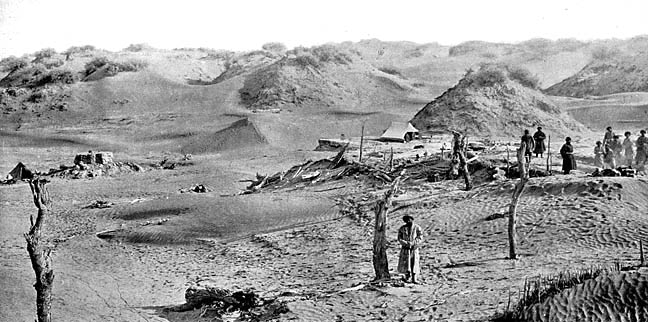
Stein's
campsite at Niya, Dec 15, 1913
Stein finished digging up two buildings and a footbridge that he had
discovered in 1906. No great treasures were found otherwise.The
photograph of his tent near the ruins is priceless.
Innermost
Asia
Miran Site
Jan 17
-Feb 1, 1914
What had irresistibly drawn me back to the ruins of Miran ever since I had left them to their solitude seven years earlier, was the thought of the fine paintings I had then been obliged to leave behind on the inner passage walls of shrine M. The full description given of them in Serindia, together with the photographs reproduced there, I will explain the exceptional interest attaching to these remains of quasi-Hellenistic pictorial art discovered in a Buddhist shrine on the very confines of China.
I discovered at once on my renewed visit on January 17th, I had failed to secure its object. In the southern hemicycle of the rotunda passage I found that the outer wall which had shown the fine fresco frieze with the representation of the Vessantara Jàtaka story and, below it, the fascinating cycle of portraits set between festoon-carrying amorini, had been laid bare and the once painted plaster surface, where not broken off, had been completely effaced through exposure.
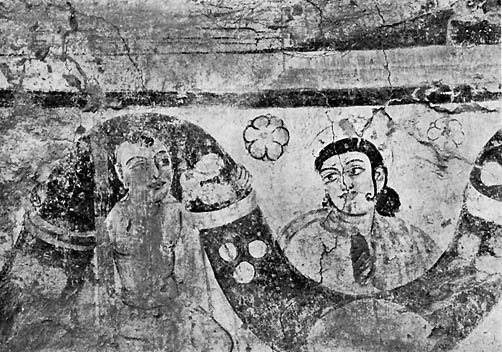
Part
of the frieze of 'armorini' rescued from the rotunda of shrine M
The Lopliks of Miran asserted that this was the result of the operations carried out three years earlier by a Japanese traveller (obviously Mr. Tachibana), who coming from the direction of Turfan had spent a few days at the site and carried away with him to Tunhuang what fragments of painted plaster he succeeded in detaching.
Thus it took fully twelve days' work at high pressure before, on the eve of my departure from Miran, the task of rescuing what was left of these fine remains of Buddhist pictorial art was finally completed. However much I must regret the loss caused by the circumstances which had prevented my undertaking that task immediately after my discovery of the frescoes, the experience now gained conclusively proved that I had then correctly gauged the technical difficulties involved and the time it would have taken to overcome them. The fragments of stucco sculpture in shrine M were the only direct archaeological interest that the complete clearing of the ruined shrine yielded.
The thirty camels I had succeeded in collecting (with the help of an Afghan trader) were by no means too many for the large amount of stores and baggage to be carried. On our journey to Loulan we had to take sufficient ice to assure minimum allowances of water for thirty-five people for at least one month, and food supplies for one month for all, and for an additional month for my own people.....
But apart from these cares I had another source of serious anxiety during these days. Within a week of my arrival at Mirân I received a letter from Sir George Macartney bringing grave news. From the head-quarters of the provincial Government at Urumchi an edict had issued ordering all district authorities to prevent us from carrying out any surveying work, and in case of any attempt to continue our explorations to arrest and send us under escort to Kashgar `for punishment under treaty'. There is no need to discuss the probable motives of this intended obstruction, or how far the alleged regulations by the General Staff of the Chinese Republic quoted in explanation
Evening after evening as I came back from the day's work at the site I looked anxiously among the indolent Lopliks at the hamlet for the first signs of the passive resistance to my plans which their natural lethargic temperament would have made it so easy to practise. Yet the expected prohibition from Charkhlik never came. That I owed this lucky escape to an opportune `revolutionary' outbreak became clear to me only later. It had disposed of the original district magistrate whose report on Lai Singh's surveys as secret operations had been responsible for Macartneys's warning.
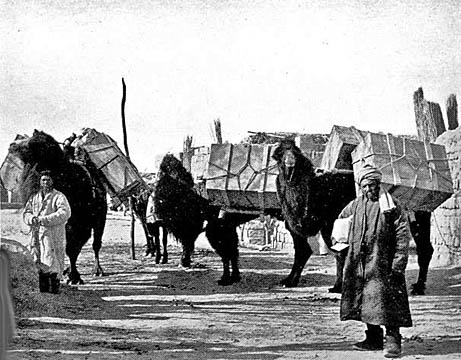
The
camels ready to carry the murals to Kashgar
On January 31, all that was needed for the move was safely collected.
On the same day the safe packing of the recovered mural paintings was
completed and their convoy was ready to start for the long journey
westwards. But what cheered me most was the prospect of soon reaching
that forbidding waterless desert where I should feel myself
completely protected from any risk of human interference.
Innermost
Asia
Loulan
Feb
7-24, 1914

Packing
the camels with ice blocks for drinking water
The immediate object of my return to the Loulan Site, L'.A., was to search its vicinity for such further ruins as might have escaped us on my visit seven years before, owing to want of time and the deceptive nature of the ground in this wind-eroded desolation.
In addition, it was to the east and north-east that I was
particularly anxious to have a search made for any clue to the line
followed by the ancient Chinese high road coming from the side of
Tunhuang.
Numerous finds
from Rubbish heaps
Stein's Move
North
Site of Ancient
Loulan
Loulan Graves
Feb
15, 1914
The reconnaissance reports had led me to expect here merely such relics as wind-erosion might have spared. I was therefore all the more delighted to find on the first rapid inspection that the summit of the Mesa north of Loulan retained a number of graves, apart from those on its edges, quite untouched by that destructive agent. They were all marked by rough tamarisk posts fixed, as subsequent examination showed, around the edges of the graves or pits, while the latter themselves were covered with layers of reeds almost entirely exposed.
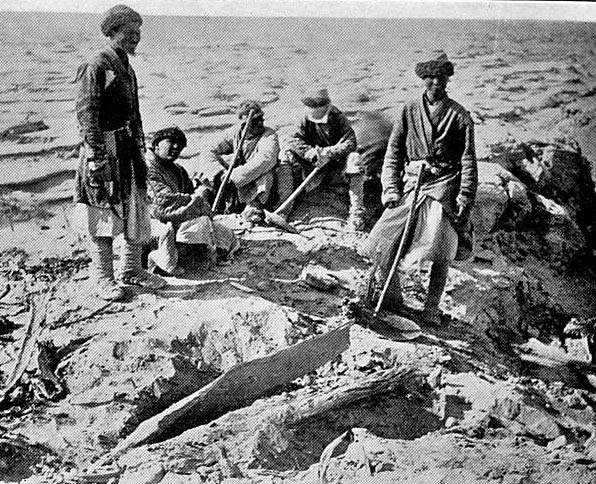
Opening
the first grave
Until the heavily laden men arrived I had to be content with
examining such relics as the partially eroded graves on the edge of
the terrace disclosed. My
hopes were abundantly fulfilled as soon as the arrival of my diggers
made it possible to start the clearing of the graves, first where
they lay near the edge of the Mesa top and then about its
centre.
Innermost
Asia
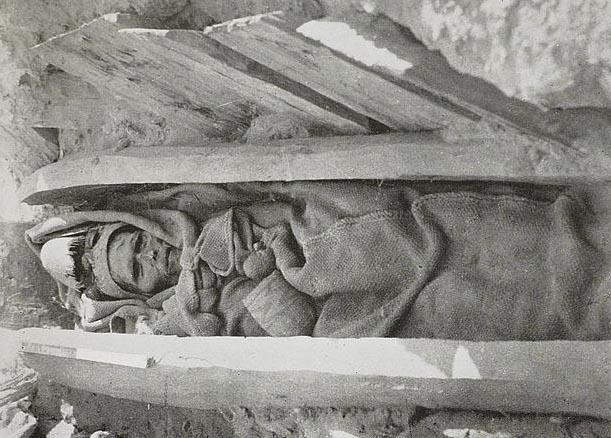
Shrouded
naturally mummified man in his grave box
Here my eye was caught at once, amidst human bones and broken boards from decayed coffins, by some rags of beautifully woven silk and wool fabrics. Their brilliant colours were excellently preserved, even where the crumbling away of the steep slope of clay had left them lying on the surface, exposed to sun and wind. Their survival under such conditions seemed a particularly encouraging augury.
|
|
|
|
Parts of shrouds from the Loulan Graves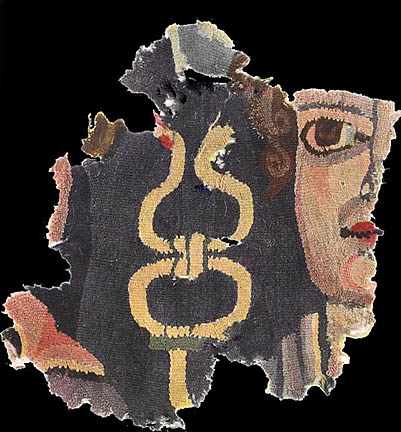
Hermes
with the staff of Aesculap, which must have come from Gandhara or
even further west.
Judging from the dated Chinese documents recovered at Loulan, the
years A.D. 263-70 were the period when the ancient desert route and
its western terminal station saw for the last time abundant traffic
and activity.
Innermost
Asia - Fabrics
The Ancient Chinese Loulan
Road
Feb 24 -Mar 14, 1914
After replenishing our ice supply and taking a carefully arranged store of fuel, we started on February 24 for our respective tasks. The one allotted to Lal Singh was to survey the unknown north-east shores of the great salt-encrusted basin representing the dried-up ancient Lop sea-bed. I myself, accompanied by Afrazgul, proposed to search for the ancient Chinese route where it left the edge of the once inhabited Loulan area and to trace it over whatever ground it might have crossed in the direction of Tunhuang.
There remained the problem how to hit the line of the ancient route and to track it onwards through ground which all through historical times had been more barren, perhaps, than any similarly large area of this globe. For a careful search of any relics left behind by the ancient traffic there would be no time. Much if not most of the object in view had to be left to good fortune, together with what hints I could deduce from previous observations. Fortune served me better than I had ventured to hope.

Crossing
the old Lopnor seabed
The last traces of dead vegetation marking the termination of the ancient delta had long been left behind when we suddenly found the old route-line plainly marked by 200 odd Chinese copper coins strewing the dismal ground of salt-encrusted clay for a distance of about thirty yards. They lay in a well-defined line running from northeast to southwest.
I was just preparing to climb a prominent Mesa which had served as our guiding-point and to use it as a look-out, when a fortunate find on its slopes of Chinese coins and a collection of metal objects, including a well-preserved iron dagger and bridle, showed that it had evidently served as a halting-place on the ancient route. So I at once decided to head straight eastwards for that bed, and the crossing effected next day proved that I had been rightly guided.
As subsequent surveys showed, we had crossed the forbidding salt seabed at its very narrowest point, and had thus escaped a night's halt on ground where neither beast nor man could have found a spot to rest in comfort. I had the satisfaction to find the ancient Chinese road still in one place plainly marked. (See the Google-Earth Map)
I now had to turn south to Tunhuang or Sha-chou, the `Town of the
Sands', as its alternative name of later origin appropriately calls
it.
Innermost
Asia
Dunhuang Magao Caves
Apr
2 - 8, 1914
In spite of the revolution which had since my former visit replaced the Chinese Empire by a republican régime, nothing appeared to have changed in the ways of quiet somnolent Tun-huang, that westernmost outpost of true China.
What occupied my mind most during those days at Tunhuang was the thought of the famous cave-temples of the `Thousand Buddhas' southeast of the oasis and of the walled-up chapel where in 1907 I had been fortunate enough to secure such abundance of ancient manuscripts and pictorial remains from a great hoard hidden away early in the eleventh century.° I knew well that so rich a trouvaille was not to be expected now. Yet I felt sincere gratification when on the very morning after our arrival at Tun-huang my earliest visitor proved to be Wang Tao-shih, the quaint little Taoist monk, whose pious zeal had brought about the first discovery of the hoard. For his discreet consideration when it came to making its treasures accessible to research, I had every reason to feel grateful.
When, a year after my own visit, Professor Paul Pelliot had gained access to, and searched, what remained of the hoard, with all the advantages offered by his great Sinologue knowledge, he carried off a considerable selection of its manuscript treasures via Peking. The attention of the authorities at the capital had thus been attracted to the old library, and its transfer there was decreed. Of the careless and in reality destructive fashion in which the order had been carried out, I had received an inkling already at Kashgar and Khotan.
Wang Tao-shih, with a bitterness only too justified, explained how, on the arrival of the order transmitted from Lan-chou Fu, the collection of manuscripts from his jealously guarded cella had been carelessly bundled into six carts and carried off to the Tun-huang Hsien Ya-mên. The packets of Chien-fo-tung rolls that I was subsequently able to rescue by purchase at Su-chou and Kan-chou clearly showed that such pilfering had continued en route as the carelessly guarded convoy slowly made its way to distant Peking.
There was accordingly special reason to feel satisfaction when Wang Tao-shih's cordial invitation to the `Thousand Buddhas' was, on the occasion of a further visit, supplemented by a discreetly conveyed hint that his store of old manuscripts was, notwithstanding all that had happened, not yet altogether exhausted. I could feel sure that he would be there in person to show me what he had managed to save from well-meant but hopelessly inefficient official interference, and not merely the big new shrine, hospice, &c., which he proudly claimed to have built with the silver `horse-shoes' received from myself.
Wang Tao-shih welcomed me cheerfully and showed with genuine pride the various new structures which his pious activity had created since I had last seen the sacred spot seven years before. Opposite to the cave-temple in which the great hoard of manuscripts and paintings had come to light, there rose now a spacious guest-house and a series of shrines filled with big gaudily painted stucco images. Near by, a garden well laid out with young fruit trees, rows of tables, brick-kilns, &c., attested the little priest's single-minded ambition to restore, according to his lights, the glory and popular attractions of the ancient sacred site. He told me that the new hospice had been built mainly with the gifts of silver made by me in 1907 in return for the 'selections' I had then been able to carry away.
I managed in the end to arrive at a mutually satisfactory arrangement. For a total donation of five hundred Taels of silver he agreed to transfer to my possession the 570 Chinese manuscript rolls of which his reserve store was found to consist. Their total bulk is sufficiently indicated by the fact that their transport required five cases, each as large as a pony could conveniently carry.
In 1920 these rolls, together with the other manuscript materials
recovered in the course of my third journey, reached a safe place of
temporary deposit at the British Museum.
Innermost
Asia
In 1906-08 Paul Pelliot had been in Tunhuang and photogarphed the
wall paintings and sculptures of 600 odd caves. His collection was
published in 1920-24. A facsimiliy edition in 6 volumes is found at
Les
Grottes de Touenhouang
Along the Han Limes via Anhsi and
Suchou-Jiaguan to Mao-Mei
Apr 14-May 14, 1914
Stein explored the eastern part of the Han Limes. - Today there is a
road, S 314, following the towers with innumerable Panoramio photos
in GE.
Innermost
Asia
Mao-Mei
May 14
and Sep 2-4, 1914
The advance of the season and the increasing heat, from which our
camels had already begun to suffer, made it imperative to push on
down the Etsin-gol and Karakhoto. It was therefore doubly gratifying
that, thanks to the help of Mr. Chou Lua-nan, the youthful Hsien-kuan
of Mao-mei, we were able, during a single day's halt on May 14th, to
hire the additional camels required to lighten the loads of our own
animals
Innermost
Asia
Sep 2-4 1914, Return to Maomei on his way north
Innermost
Asia
Karakhoto
May 26
- June 5, 1914
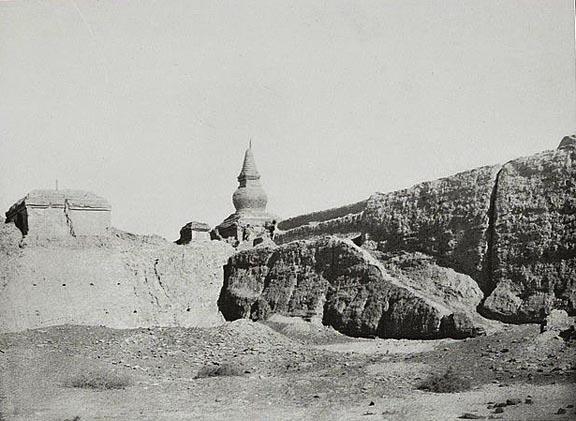
The
Walls of Karakhoto still extant today
The most striking ruins of Khara-khoto, the Etsina of Marco Polo, are its circumvallation. The walls are built of stamped clay and reinforced by a wooden framework of which the big rafters could be traced in three rows all round the inside faces of the walls. But in most places their position is marked only by the holes which the decayed timber has left. The walls are about 38 feet thick at the base, but show a considerable inward slope so that the width at the top, about 3o feet from the ground, is only 12 feet. With the massive solidity of the circumvallation and its comparatively good preservation the utter decay and consequent emptiness of the interior of the town presented a striking contrast.
Among the deposits of rubbish, composed mainly of stable refuse, chippings of wood, broken pottery, &c., those found along the sides of what appeared to have been the chief thoroughfares were the largest. Among the records thus recovered, those in Chinese were by far the most numerous, and so far as appeared from a hasty examination at the time, all, with the exception of some printed pieces, were hand-written.
A rough inventory prepared before the submission of the Khara-khoto
material to various collaborators shows a total of some 230 Chinese
documents and fragments from this source, as against 57 pieces in the
Hsi-hsia or Tangut script, close on half of these being printed. The
presence of Hsi-hsia pieces, both written and printed, suffices,
however, to prove that the town must have been inhabited during the
period of the Hsi-hsia dynasty (A. D. 1032-1227), as its founder is
known to have first introduced that script. But its occupation, so
far as this documentary at present goes, might well have continued
also long after the destruction of the Tangut kingdom by Chingiz Khan
in 1227.
Some quasi-palaeographical interest attaches to the fact
that of the remains of Hsi-hsia and Chinese texts, whether written or
printed, almost all are of the oblong book form, which, originating
from the 'concertina ' arrangement of leaves illustrated by later
Chinese manuscripts from the Chien-fo-tung hoard, has been in regular
use for block-printed literary products in China since the early Sung
period.
The western portion of the town appeared to have been mostly occupied by shrines. But among these only very few retained more than the foundations of their walls or outlines of platforms.
The rapidly increasing heat made work at Khara-khoto very trying both
for the men and for the camels, upon which we depended for the
transport of water. So I was glad when, our work at the site being
completed and Lai Singh having returned from his survey towards the
terminal lake basin, I was able on June 5th to move my camp back to
Tsondul on the Ikhe-göl and there to arrange for our journey south
to the foot of the Nan-shan.
Innermost
Asia
Marco
Polo and the history of Karahhoto
Kanchou-Zangye
July
and Aug 2- 22, 1914
Seven years later, in the summer of 1914, my third expedition brought me once again to the large city of Kanchou and the great oasis at the foot of the Nanshan of which it is the centre, just as in the days when Marco Polo stayed there. It was to serve as our base for the new surveys which I had planned in the Central Nanshan. Their object was to extend the mapping which we had effected in the high mountain near the sources of the Suloho and Suchou rivers by surveys of the high ranges farther east containing the headwaters of the river of Kanchou.
The Aborted Nanshan Survey
A serious riding accident
July 12 - Aug 2, 1914
Accompanied by the two surveyors I had tramped on for fourteen miles by the track leading above the left bank of the O-po-ho, when we were brought up by a side stream swollen by the rain and too deep to be crossed without mounting. There I met with a very serious riding accident which might well have put an end for ever to all my travelling. My Badakhshi stallion, my regular mount all the way from Kashgar and ordinarily a quiet enough animal, probably excited by the many brood mares we had passed on the march, began to plunge as soon as I had mounted, reared suddenly, and overbalancing himself fell backwards upon me. Had it not been for the sodden condition of the turfy soil, the weight of the tall animal would probably have badly crushed me.
Even so the result was serious enough. Apart from bad bruises the
muscle of my left thigh was severely injured, the main muscle
evidently torn. Walking at once became impossible, and the pain made
even carriage on the linked arms of my two surveying companions
impossible. With my leg badly swollen and other injuries, any
movement even on my campbed was for some days most difficult. But I
soon diagnosed that my limbs had luckily escaped fracture or
dislocation. By the first week of August I had sufficiently recovered
from the accident to get myself carried down in an improvised pony
litter to Kanchou, my leg still feeling severely the strain. During a
ten days' halt there in my peaceful temple quarters I experienced
much kindness from Fathers Van Eecke and De Smedt of the Belgian
Mission
Innermost
Asia
Peishan Traverse from Maomei to
Barkul
Sep 3 - Oct 4, 1914
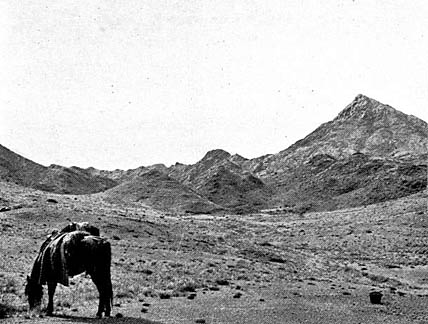
The
desolate landscape of the Peishan
This was Mongol territory who were highly defensive towards intruders. In addition Stein had hired two Chinese-speaking guides, who claimed to have travelled the route, but led his carvan repeatedly into dead-end valleys. - The following excerpts were selected to show the desolateness and monotony of the terrain. --
From Maomei a perfectly open plateau stretched away to the north-west, sloping up gently in that direction and sending its dry drainage beds down towards the northeast. On the gravel surface; bare but for scanty tufts of scrub, the caravan track showed up clearly and allowed us to cover with ease a march of close on 25 miles to the well of the Nan-ch'üan.
Our march of September 9th took us, after we had proceeded about 13 miles, across the crest of another gently rising and much broken hill chain, at an elevation of about 5,300 feet.
On September l0th a short march took us first over an utterly bare plain of gravel, where only strips of detritus 10 to 15 feet high marked the position of low ridges completely decomposed.
A day's rest by the springs and luxuriant reed-beds of Lo-Co-ch'üan was a boon to men and beasts alike. Then on September 13th we set out to the north-west on a march which proved distinctly interesting. It took us first over a bare stony Sai covered with the detritus of ridges that had almost completely worn away. After passing several dry beds, all descending from the west, we entered a region of low rocky hillocks, 20 to 30 feet high and of rounded forms, rising above the sea of detritus. There could be no doubt of their igneous origin.
The defile through which the ascent led on the morning of September 14th narrowed rapidly; it lay between rocky hills, much worn and picturesque, rising to heights of 300 to 500 feet above the valley bottom.
September 16th an easy march of about 16 miles to a well that a Chinese-knowing Mongol had spoken of as Liu-kou.
The apparent nearness of our immediate goal, on the route from Su-chou to Hâmi, induced me to pass the small patch of vegetation that the Mongols had mentioned to us under the name of Yen-chi and to push on.
At the foot of the hills we stumbled on a dry stream-bed with a big cairn showing above on the sky-line. Some coarse grass was found near the bed, and there we halted for the night, after having covered a distance of 32 miles. The camels did not arrive till next morning, some of the animals having broken loose and strayed, and the men sent to search in the neighbourhood found only a square walled enclosure in ruins, but neither well nor fuel. The gale had somewhat abated in the evening; yet the bitter cold kept most of us awake that night. At daybreak our hapless `guides' discovered the well of Ming-shui about a mile away.....
We finally reached Barkul after four weeks of struggle on October 4,
1914
Innermost
Asia
Turfan
Oct 25 -
30, 1914
My arrival, on October 25th, 1914, close to the town of Turfân
marked the beginning of the season that I proposed to devote to
archaeological and geographical labours in the Turfân
basin.
Innermost
Asia
Kara-khôja – Gaochang
Nov
1 - 14, 1914
|
|
|
On Nov 1 I moved my camp to Kara-khôja, which, by its conveniently
central position offered an easy access to a series of important
sites. My first stay at Karakhôja, which extended to November 14th,
was mainly taken up with a series of preliminary tasks connected both
with our archaeological and our topographical work. I paid
preliminary visits in succession to the cemetery sites near Karakhöja
and its large sister village Astâna, and to the cave-shrines of
Toyuk and Bezeklik.
Innermost
Asia
Toyuk
Nov 23 -
Dec 13, 1914
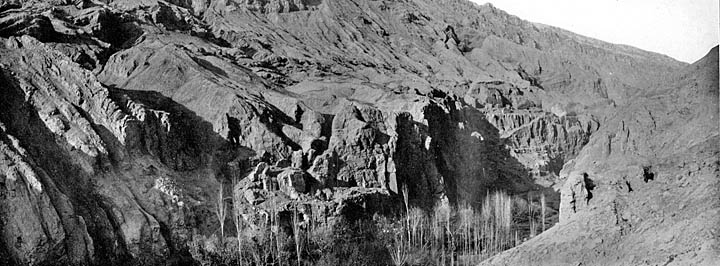
On November 23rd I returned to Toyuk and camped during the next fifteen days at that most picturesque of all Turfan localities. During this halt I devoted as much time as my other duties would allow to the work which my previous reconnaissance of the often-searched and plundered ruins of Toyuk suggested as still worth undertaking.
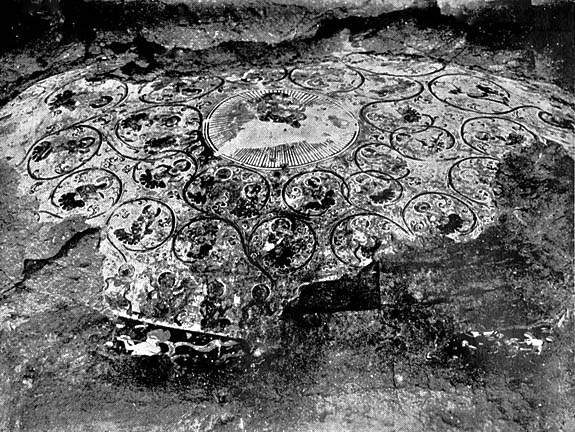
Ceiling
of the flat-shaped dome over the cella.
I was therefore obliged to confine my own work to those few spots
where heavy accumulation of debris or other difficulties of the kind
appeared to have deterred the diggers, and to the rescue the chief
object of interest that had survived in this shrine: the painted
ceiling of the flat-shaped dome over the cella.
The ground of the
painted ceiling was formed of a fairly hard plaster, mixed
cement-like with small pieces of gravel. Small wooden pegs driven
into the rock served to secure this plastering. The removal of the
whole painted ceiling was the only means of saving this fine piece of
decorative art from risks of further destruction. Owing to the
position and the hardness of the plaster, this operation offered
considerable practical difficulty, which, however, was successfully
overcome by Naik Shamsuddin's skill and devoted care. Only when the
twenty-one panels in which the painted surface of the ceiling was
removed shall have been set up once again at New Delhi in their
proper position, will it be possible to render a full account of this
remarkably graceful composition.
Innermost
Asia
Emergency Trip to Urumchi
Dec
18, 1914 - Jan 3, 1915
The journey along the high road from Turfân town to the provincial headquarters in Urumchi and back, together with a week's stay in Urumchi, occupied my time between December 18th and January 3rd. The rapidity of the marches by which the distance of some 115 miles between the two places had to be covered, shed light on the difficulty I still experienced in walking. I hoped to obtain advice as regards my injured leg from the medical officer attached to the Russian Consulate at Urumchi ; though slowly improving, its condition still continued to be a cause of anxiety and impediment. But even without this personal motive I should have felt obliged to undertake this journey for quasi-diplomatic reasons.
Notwithstanding the helpful intercession from Peking secured in the
spring by the British Minister, I had reason to apprehend that the
spirit prompting the official obstruction, which in November had
seriously threatened to bring both my archaeological and geographical
work to a standstill, had by no means disappeared from provincial
head-quarters. As the sequel showed, this apprehension was only too
justified. In order to guard against this risk, or at least to delay
the resumption of obstructive tactics, it seemed clearly advisable to
endeavour by a personal visit to secure a more favourable attitude of
those in power at Urumchi, and in any case to assure myself of that
friendly support of Pan Ta-jên which had proved so helpful in the
course of my first two journeys.
Innermost
Asia
Murtuk
Dec 9,
1914 - Jan 17, 1915
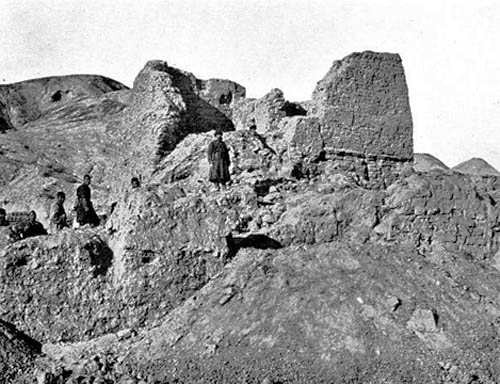
Ruins
at Murtuk before excavation
After my return from Urumchi, on December 9th I left Toyuk and moved
my camp past the oases of Su-bâshi and Sengim north of the outer
hill range to the village of Murtuk. My renewed stay at Murtuk
extended to January 17th and was devoted mainly to the closer
examination of the Bezeklik shrines and the selection of additional
frescoes for removal. During these days I was also able to make a
survey of the several small groups of ruined Buddhist shrines
situated at the mouths of the little valleys that descend towards the
deep-cut e Yar' of Murtuk from the bare hills to the south-west and
south of the village.
Innermost
Asia
Bezeklik
Dec 9,
1914 - Jan 17, 1915

Bezeklik,
Buddha from a Paranirvana scene
I had previously made a reconnaissance from Karakhôja to the many cave-temples and shrines of Bezeklik. This visit had shown me that those shrines still retained a great portion of their wall-paintings. But it had also afforded unmistakable evidence of the increased damage which the pictorial remains of this, the largest of the Buddhist sites of Turfân, had suffered from the hands of local vandals since my first visit in November 1907.
A year before that (1906), Professor Grünwedel had stayed a two months at the site and devoted all his archaeological care and expert iconographic knowledge to the complete excavation and study of its remains. Many of the most interesting specimens of the paintings on the walls of the Bezeklik temples were then removed by A. von Lecoq for safety to the Ethnographic Museum of Berlin, as had been, two years earlier, the remarkably well preserved fresco panels of the shrine which Professor von Lecoq had found filled with debris and had cleared before Professor Grünwedel's return to Turfân.
With the sad proofs of progressive damage before my eyes, I could feel no doubt that removal offered the only means of assuring their security. This was the important task which brought me now to Murtuk, and to which I devoted the greater part of two successive stays of an aggregate length of fifteen days.
Astana Cemetery
Jan
19 - 31, 1915
Our work at the Astâna cemeteries was begun on January 19th with the examination of tombs which, without showing an enclosure of embanked gravel, might yet, by their arrangement in more or less parallel rows, be recognized as a separate group marking the extreme north-eastern extremity of the area. Among this group, Ast. 1, which comprises a considerable number of tombs had manifestly been searched in recent years. But in the middle row the majority appeared to have escaped.
The fabrics which clothed the dead, plain cotton and snuff-coloured
silk, had rotted away into shreds. But the mask-like covers of silk
placed over the faces had survived better and revealed, when removed,
interesting details in connexion with the last toilette of the dead.
In the case of the larger body, a, obviously male, which lay eastward
of the other and nearer to the entrance, the face-cover contained in
the middle a piece of figured silk showing a very fine design of
distinctly `Sassanian' style.
Below this cover was a pair of
`spectacles', placed over the eyes, consisting of a thin plate of
silver, formed into two lotus petal-shaped pieces which were joined
end to end. The slightly embossed centre of each is punched with a
number of small holes and the flattened edges drilled for sewing on
to the silk with which the surfaces were covered. The exact objective
intended to be served by these 'spectacles', of which further
examples were recovered on other bodies, still remains to be
ascertained.
However, the most curious and instructive discovery here made was the following. Mashik, our special cemetery assistant, whom long practice in searching the dead had relieved him of all scruples, by breaking the jawbones of the skull recovered from the mouth cavity a thin gold coin which I was able at once to recognize as Byzantine. It has since been identified by Mr. R. B. Whitehead as an approximately contemporaneous imitation of a gold coin of the Emperor Justinian I (A. D. 527-65). This at once supplied a terminus a quo for this particular group of tombs.- It must further be borne in mind that as China had never had a gold or silver coinage, those who at Turfân wished to provide their dead with an adequate obolus for the journey to the world beyond would necessarily have to use a coin of Western origin for their pious purpose, if they wished it to be of precious metal.
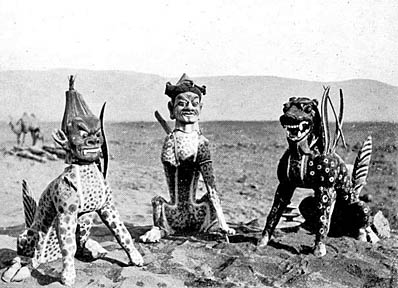
Sassanian
Buddhist Protectors – which Stein calls “Monsters”
Thrown on one side lay the clay figure of a monster, with a grinning human head and the body like that of a panther, sitting on its haunches and wearing a three-cornered hat. The grotesque head was well modelled, the colouring of the whole crude. The body was painted pink in front and blue at the back, both sides being covered with bright red spots. A bushy blue tail and four wing feathers found broken added to the grotesque look of the monster. Like two other monsters found in the same part of the cemetery this demon was probably meant to keep off evil spirits from the abode of the dead, like the Tu-kuei figures found in Tang tombs of China.
|
|
|
|
Pieces of fabric from Tang gaves (Mid 7th cent) with Sassanian motives
|
|
|
|
Grave deposits of clay and wood from the late 7th century
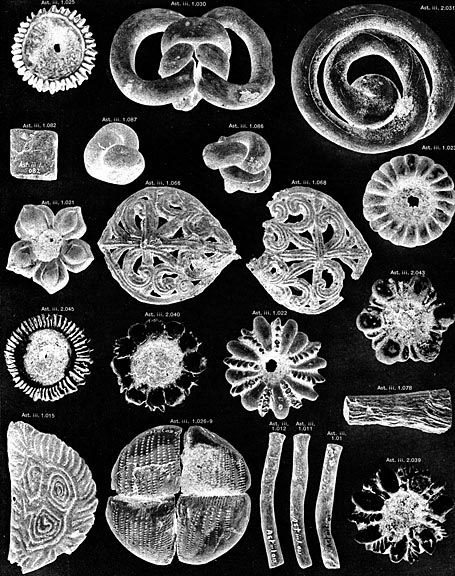
Pl.
XCII, Real baked pastry
The remains of fine pastry recovered here are as remarkable for their
variety of shapes as for their excellent conservation. As PI. XCII
shows, there are represented among them flower-shaped tartlets of
different kinds with neatly made petal borders, some retaining traces
of jam or some similar substance placed in the centre ; bow-knots and
other `twists'; buns, divided cross-wise, `cracknels', and `straws'.
More elaborate productions of the confectioner's art are the thin
ornamented `wafers', and the ogee-shaped open-work cakes, with finely
ribbed sprays of foliage, &c. Some black grapes also were found
here, shrivelled but otherwise in good condition. Considering the
brittleness of all this pastry it seems difficult to believe that it
could have occupied the place where it was found before the coffin
was removed from there.
Innermost
Asia
Anxious as I was personally to assure their security, it was impossible to drag about with me these loads, which, when all the wall-paintings from Bezeklik had been removed and packed, amounted to 145 cases weighing over eight tons(!).
Arrangements had therefore to be made for the dispatch of the antiques to the safe shelter of the Consulate General at Kashgar, and in the first days of February I observed signs calculated to make me hasten these arrangements, as well as the conclusion of my excavations at Astâna.
In the first days of February I observed signs calculated to make me
hasten these arrangements, as well as the conclusion of my
excavations at Astâna. Communications from the well-meaning District
Magistrate of Turfan, politely conveyed yet unmistakable in their
disquieting import, indicated that official inquiries had been made
from head-quarters at Urumchi as to the reasons for my prolonged stay
in the district, the character of my work, &c.
By February 5th
the last big batch of cases containing frescoes had been duly brought
in from Bezeklik. A day later I saw with no small relief the long
string of forty-five laden camels starting for their distant
destination under the care of Ibrahim Beg, the veteran factotum who
had accompanied me on three journeys. Repacked like the rest of my
collection with systematic care at Kâshgar, the contents of all
these cases reached their Indian destination without loss or damage.
The setting up of the Bezeklik frescoes in the building erected for
their accommodation at New Delhi has been progressing ever since
1921.
Innermost
Asia
Korla
Mar 30 –
Apr 6, 1915
After a streneous 45-day march through the uncharted wastes of the Kuruk-Tagh mountains to the northernmost grave sites of the Lopnor, and along the Konche-Darya River from there they reached Korla town on March 30, 1915. -
On April 6th we set out in three separate parties for the long
journey to Kashgar. A variety of reasons, largely connected with my
plans for travels during the summer in the Pamir region and for work
during the winter in far-off Sistân and also with the safe packing
and dispatch of my antiquities to India, made me anxious to reach it
by the close of May.
Lai Singh's task was to keep close to the
Tien-shan and to survey as much of the main range as the early season
and the available time would permit. Muhammad Yäqûb was sent south
across the Konche and Inchike rivers to the Yarkand-darya with
instructions to survey as much as conditions would permit of its main
channel as far as the northern edge of the Yarkand district. Most of
our camels were sent with him under very light loads, in order that
they might benefit by the abundant grazing in the riverine jungles
after all their privations and before the time came when I should
have to dispose of them.
I myself felt obliged, in the interests
of antiquarian research, as well as in view of the great distances to
be covered within the available time—my marches between Korla and
Kashgar aggregated some 938 miles in 55 days—to keep in the main to
the long line of oases which fringes the southern foot of the
Tien-shan.
Innermost
Asia
Kashgar 2
May 31
- July 6, 1915
My arrival at Kashgar on the morning of May 31st had brought me back to my familiar base in time to benefit by all the friendly assistance and official support which Colonel (since Brigadier-General) Sir Percy Sykes, who had temporarily replaced Sir George Macartney as H.B.M.'s Consul-General, could give me before his departure a week later for a shooting trip in the Russian Pamirs.
The most troublesome part of this work and that which took longest time was the careful repacking of my collection of antiques for its long and difficult journey across the Kara-koram to Ladak and thence to Kashmir. The assemblage of the requisite materials and the careful sorting and packing of the antiques, many of them of an extremely brittle and friable character, kept my assistants and myself busy for fully five weeks. It was due mainly to the care then taken that the fragile contents of those 182 tin-lined cases, after a difficult journey of over 800 miles through high mountain ranges and across ice-covered passes on camels, yaks and ponies, finally reached Kashmir safely.
Amid the mass of work which kept me fully occupied all through that
hot month of June, none caused me more concern than the arrangements
for my long-planned journey across the Russian Pamirs and through the
mountains and valleys north of the Oxus.
I had conveyed the
request that I might be enabled, with the permission of the Imperial
Russian Government, to make my way from Kashgar towards the
Trans-Caspian railway and thus to northeastern Persia and Sistan by
the route which the ancient silk trade may be assumed to have
followed across the Alai and along the Kara-tegin valley.
On the 6th of July I at last found it possible to leave Kashgar,
after completing all arrangements for the safe passage of the eighty
heavy camel-loads of antiques to India. But the summer floods in the
Kun-lun valleys, due to the melting glaciers, would not as yet allow
of the departure of this valuable convoy towards the Kara-koram
passes.
Innermost
Asia
Through the Russian Pamirs to
Samarkand
Jul 6 – Oct 22, 1915
Lake Victoria – Kara-Kul
August
27, 1915
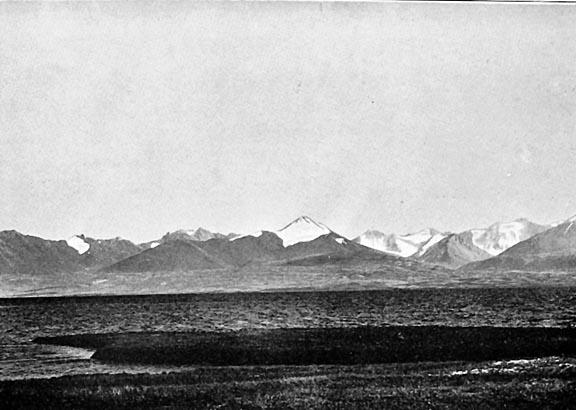
Karakul
Lake from its eastern shore
Ever since my youth I had longed to see the truly 'Great' Pamir and its fine lake, of which Captain John Wood, its modern discoverer in 1838, had given so graphic a description. This desire was greatly increased when the closer knowledge since gained of the topography of the Pamir region had confirmed my belief that the memories of those great old travellers, Hsian-tsang and Marco Polo, were associated with the route leading past the lake. The day of halt, August 27, spent by the sunny lake shore was most enjoyable.
Bartangh River
Sep
28, 1915

Down
the Bartangh River in a coracle
Across the Shitam Pass into the
Roshan
Sep 21, 1915
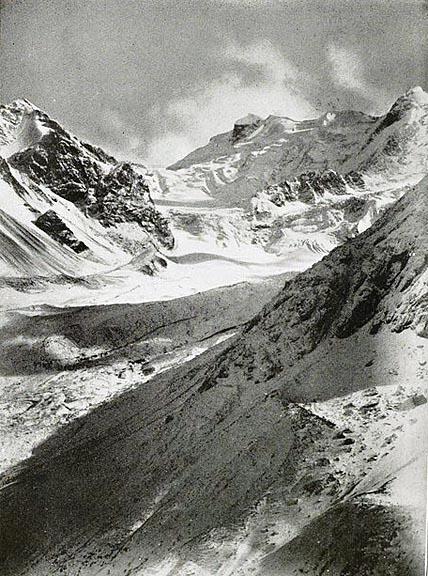
Shitam
Pass, 5282m
For progress to Roshan, the mountain tract adjoining Shughnan on the north, it would have been easier to descend the Ghund valley to the Oxus below Khoruk and then from Kala-Bar-Panja on the opposite side to have followed the right bank of the river by the newly made Russian bridle-path down to Kala-i-Wamar, the chief place of Roshan. But I was anxious to see something of the high snowy range, dividing Shughnan from Roshan and the drainage of the Bartang river, which I had first reached more than a month before at Saunab. So I preferred to make my way to Roshan by the high pass which leads across the range from above the small village of Shitam. Light as our baggage was, it proved impossible to take it on laden ponies beyond a point about 12,600 feet above sea-level.
On the ascent made next day with load-carrying men, it was necessary
alternately to advance over a much-crevassed glacier and to climb
steep rock couloirs before, after six miles of such trying progress,
the narrow arête of rock forming the pass was reached at an
elevation of some 16,100 feet. The magnificent views opening from
this height were a fit reward for our toil.
Innermost
Along the Upper Oxus Valley to
Samarkand
Oct 14 - 20, 1915
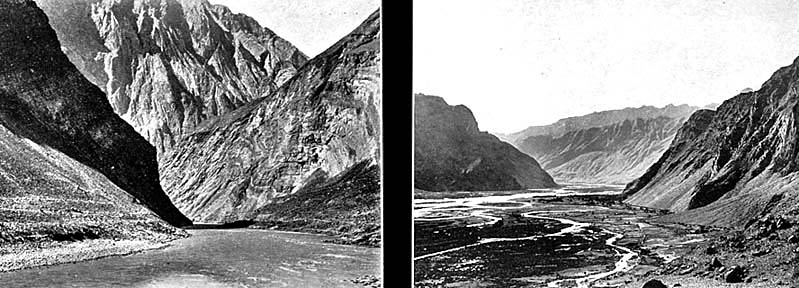
The
Oxus Gorge and its upper Valley
Starting on October 14th from Ab-i-garm I left behind the last of the valleys which descend from the Pamir region, and also the westernmost portion of that ground within the drainage area of the Oxus with which I could hope to gain some closer acquaintance on this journey. Regard for the time needed to reach my next goal in distant Sistan and for the work planned there before my return to India obliged me to seek the Trans-Caspian railway at Samarkand by the nearest route and as quickly as possible. The nine rapid marches, covering some 270 miles, which brought me there across comparatively well-known parts of the Bokhara hills offered little chance for close observation.
After crossing another fine plateau, that of Kinnak, which nomadic Özbegs, known as Kongrad, from the tracts north of the Oxus frequent for its grazing, we reached the town of Shahr-i-sabz, in the wide and abundantly irrigated valley draining towards Karshi, on October 20.
Samarkand
Oct 22,
1915
Thence on the following day a long and dusty drive carried me across the Takhta-karacha pass and the wide peneplain overlooking the Zarafshàn valley to Samarkand.
The extensive repairs that our baggage and kit needed after three months of rough travel in the mountains, together with other work, detained me for two days in this great busy city. Its Russian part appeared to have grown greatly since my first visit in 190I and looked even more than before like a town of Eastern Europe. Having previously visited the noble monuments of Timûr's period, I employed my present stay to inspect the plateau of Afràsiab, covered with debris mounds, to the east of the present city. It marks the site of the ancient capital of Sogdiana, the K`ang-chii or Sa-mo-chien of the Chinese records and the Maracanda of Alexander's historians. --
From Samarkand Stein went by train to Ashkhabat and from there,
skirting the border of (closed) Afghanistan, to Mount Kwaja and the
province of Sistan, Iran to perform further archeological
investigations in Southeastern Iran.
Innermost
Asia
Nasratabad, Sistan
Dec 1-6, 1915
Our march of November 30, which brought us over a
vast fan of detritus and gravel down to the shore of the Hamun, the
great terminal basin of the Helmand, was of a kind to bring back
vivid memories of a familiar desert region of innermost Asia. For the
ground over which we travelled here for more than 32 miles was just
like that over which the approach lies to the shores of Lake Hamun. A
day's march from the Hamun to Nasratabad. There I was most kindly
received by Major (since Lieutenant-Colonel) F. B. Prideaux, H.B.M.'s
Consul for Sistan and Kahn.
Innermost
Asia
Mount Koh-i-Khwaja and the Fort of
Ghâla-kôh
Dec 6, 1915-Feb 18, 1916
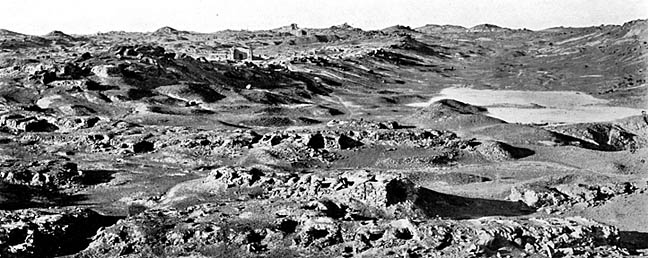
Koh-i-Khwaja,
View from the Ghâla-kôh Fort.
The top of Ghâla-kôh commands distant vistas over the isolated peaks and ridges into which the Ghâla-kôh range skirting from NW. to SE. is broken up at this end, and over the much-eroded slopes where side spurs have `matured' into bare hummocky peneplains. A veil of dust haze, like that which I had seen so often lying over similar landscapes at the foot of the K'un-lun or the range above Kashgar and Yarkand, hid the plains of ancient Drangiana far away to the east.
|
|
|
On December 6th I left the hospitable roof of the British Consulate
at Nasratâbad for Kôh-i-Khwaja, and passing next morning beyond the
village of Daudi over flat uncultivated ground liable to inundation,
arrived at the edge of Lake Hamun where it faces the rock island of
Kôh-i-Khwaja. My reason for visiting the ruined site to be found
there first was that this conspicuous hill, rising in complete
isolation more than 400 feet above the central portion of the Hamun
marshes and the level expanse of the Helmand delta, bears on its top
much-frequented Muhammadan shrines which form the object of regular
pilgrimages. Its sanctity is marked by its very name, the `hill of
the Saint', i. e. `Ali.' The very striking natural features of this
hill, rising as it does in the very center of a wide lacustrine
basin, were certain to have attracted local worship from early times,
and belief in the tenacity of such worship suggested a great
antiquity of the ruins.
Innermost
Asia
The citadel complex was first investigated by Marc Aurel Stein in
1915-1916. The site was later excavated by Ernst Herzfeld, and was
again investigated by Giorgio Gullini in a short expedition of 1960.
Initially, Herzfeld tentatively dated the palace complex to the 1st
century CE, that is, to the Arsacid period (248 BCE-224 CE). Herzfeld
later revised his estimate to a later date and today the Sassanid
period (224-651 CE) is usually considered to be more likely. Three
bas-reliefs on the outer walls that depict riders and horses are
attributed to this later period. Beyond the citadel at the top of the
plateau are several other unrelated buildings, of uncertain function
and probably dating to the Islamic period.
Wikipedia
By train from Nushki to
Srinagar
Feb 21 – Mid March, 1916
On February 21, 1916 I reached Nushki, whence the railway carried me first to Quetta and subsequently to Sibi, the cold weather head-quarters of Sir John Ramsay, then Governor-General's Agent and Chief Commissioner, of British Balûchistân.
Finally, after the middle of March, I reached Kashmir, which had been
the base for all my Central-Asian expeditions and from which I had
started close on two years eight months before. There at Srinagar the
182 cases of my collection of antiquities from Chinese territory had
safely arrived by the previous October.
Innermost
Asia